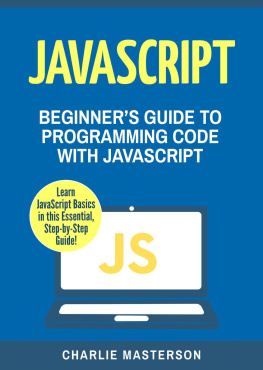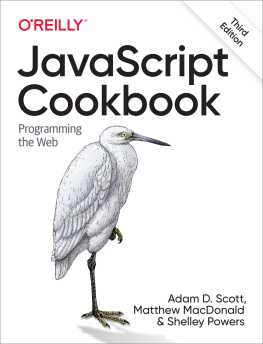Masterson - JavaScript: Best Practices to Programming Code with JavaScript
Here you can read online Masterson - JavaScript: Best Practices to Programming Code with JavaScript full text of the book (entire story) in english for free. Download pdf and epub, get meaning, cover and reviews about this ebook. year: 2017, genre: Romance novel. Description of the work, (preface) as well as reviews are available. Best literature library LitArk.com created for fans of good reading and offers a wide selection of genres:
Romance novel
Science fiction
Adventure
Detective
Science
History
Home and family
Prose
Art
Politics
Computer
Non-fiction
Religion
Business
Children
Humor
Choose a favorite category and find really read worthwhile books. Enjoy immersion in the world of imagination, feel the emotions of the characters or learn something new for yourself, make an fascinating discovery.
- Book:JavaScript: Best Practices to Programming Code with JavaScript
- Author:
- Genre:
- Year:2017
- Rating:5 / 5
- Favourites:Add to favourites
- Your mark:
- 100
- 1
- 2
- 3
- 4
- 5
JavaScript: Best Practices to Programming Code with JavaScript: summary, description and annotation
We offer to read an annotation, description, summary or preface (depends on what the author of the book "JavaScript: Best Practices to Programming Code with JavaScript" wrote himself). If you haven't found the necessary information about the book — write in the comments, we will try to find it.
JavaScript: Best Practices to Programming Code with JavaScript — read online for free the complete book (whole text) full work
Below is the text of the book, divided by pages. System saving the place of the last page read, allows you to conveniently read the book "JavaScript: Best Practices to Programming Code with JavaScript" online for free, without having to search again every time where you left off. Put a bookmark, and you can go to the page where you finished reading at any time.
Font size:
Interval:
Bookmark:
JavaScript:
Best Practices
to Programming Code
with JavaScript
Charlie Masterson
Table of Contents
Copyright 2016 by Charlie Masterson - All rights reserved.
The following eBook is reproduced below with the goal of providing information that is as accurate and reliable as possible. Regardless, purchasing this eBook can be seen as consent to the fact that both the publisher and the author of this book are in no way experts on the topics discussed within and that any recommendations or suggestions that are made herein are for entertainment purposes only. Professionals should be consulted as needed prior to undertaking any of the action endorsed herein.
This declaration is deemed fair and valid by both the American Bar Association and the Committee of Publishers Association and is legally binding throughout the United States.
Furthermore, the transmission, duplication or reproduction of any of the following work including specific information will be considered an illegal act irrespective of if it is done electronically or in print. This extends to creating a secondary or tertiary copy of the work or a recorded copy and is only allowed with express written consent from the Publisher. All additional right reserved.
The information in the following pages is broadly considered to be a truthful and accurate account of facts and as such any inattention, use or misuse of the information in question by the reader will render any resulting actions solely under their purview. There are no scenarios in which the publisher or the original author of this work can be in any fashion deemed liable for any hardship or damages that may befall them after undertaking information described herein.
Additionally, the information in the following pages is intended only for informational purposes and should thus be thought of as universal. As befitting its nature, it is presented without assurance regarding its prolonged validity or interim quality. Trademarks that are mentioned are done without written consent and can in no way be considered an endorsement from the trademark holder.
Welcome to our book, "JavaScript: Best Practices to Programming Code with JavaScript. Whether you are a beginner with coding or have been doing it for a while, you know how hard JavaScript can be! Even the simplest mistakes can mess up your entire code! We are here to tell you that it happens with everyone! You are not alone in this situation. It is how you handle these mistakes that could differentiate you from the other coders.
Do you just give up because of one mistake? Of course not! Life is all about making mistakes, and learning from them. Within these chapters, we will be teaching you some basic practices to enhance your skills within JavaScript. We will be giving you the best methods, processes, and techniques that will help lead to a better JavaScript programming code. As you learn, you will be able to apply your new skills to everyday life.
Our goal is to have our readers proficient in JavaScript code, so they can expand their knowledge by reading this book. If you are at this point, we expect that you have some previous knowledge of JavaScript, even if it is just the basics. Sometimes, JavaScript books can be frustrating. The code is not always an easy topic to explain clearly. We promise to make this coding process as simple as possible.
For our first chapter, we will be going into depth on some of the common JavaScript mistakes every coder has done. You may find that you aren't the only one making some of these errors. In fact, some seem silly to be messing up! Don't worry; sometimes it is the smallest mistakes that are the easiest to fix! Perhaps you are skipping attention to detail such as mismatching quotes or even changing your variable names. Were you aware that properties and variable names were case sensitive? If not, we have got you covered!
After the common mistakes, we will go over some general recommendations to help improve your code. For example, we will be going over how to define your local vars, how to avoid global variables and more! Once we have discussed the general recommendations, we move onto tips to improve your comments, logging, and overall performance. As we stated before, our primary goal is to develop your skills as a coder.
As you read, please feel free to stop and practice the codes we provide. After all, practice makes perfect! Eventually, coding will become more natural for you and you won't have to stop and think about the code as much. Of course, errors are bound to happen, but as you learn you may find yourself making less of them. We hope that you enjoy the read and will learn a thing or two while you're at it!
Chapter 1:
Common JavaScript Mistakes
Yes, you probably know all of the codes to follow. Just remember that coding in JavaScript can trip you up, no matter how long you've been working with code. The following examples are some of the common traps people fall into. When you are working, try to keep these models in your mind. This way, when you are coding or debugging, you will catch yourself sooner!
Mismatching Quotes, Curly Brace, and Parenthesis
If you do this a lot, there is an easy way to avoid the mistake. All you will need to do is to code your opening and closing elements at the same time! After you do this, you can enter your element that you want to add to your code. Here is an example:
CODE
var myString=" ";
function myFunction(){
if(){
}
}
- First line, you want to code the quotes before you even enter your string value. This way, you dont forget them.
- In your second line, close every bracket as soon as you open it.
- Within your code, be sure you double check and count the left and right parenthesis within your code. You will want to double check and make sure that they are equal
- Finally, if you open a parenthesis, be certain you close it!
Case Sensitive
In case you arent already aware, functions and variables are both case sensitive. While you are working, it can be VERY easy to make this silent error. When you are picking names, we suggest you stick with it. As a small tip, just remember that the CSS properties within JavaScript are going to be camelCase. Heres a quick example:
getElementById("theId") != getElementByID("theId");
- Did you catch the mistake? Instead of "ID" it should have been "Id"
getElementById("theId") != getElementById("theID");
- What about this time? You got it! "Id" will not equal "ID." You can see how this is a common mistake, especially if you are trying to move quickly!
Line Breaks and Extra Commas
When you are coding, you will want to stay away from hard-line breaks. When you use line breaks, they will be interpreted as a line-ending semicolon. This can also happen in a string. When you include a hard line break in your quotes, you are going to get an error. It will most likely be the unterminated string parse error. Here is an example:
- Unterminated String Error:
var bad=- writing the text
- even more text
- Correct Line Break
var good= '- ' +
- writing the text ' +
- even more text ' +
'
'
' - It should be noted that this semi-colon rule will not hold true with control structures. In control structures, a line break AFTER your closing parenthesis is not given by a semi-colon.
- To fix this mistake, you will want always to use semi-colons and parenthesis. This way, your code is easier to read, you will not get tripped up by the breaking lines, and when you move your code around, you will never have to worry about your initial statement closing.
- If you have extra commas, remember that your last property should not end with a comma. While some browsers won't be tripped up by the extra commas (such as Firefox), Internet explorer will. Just try and remember that it is better to be safe than sorry when you are working with code!
Font size:
Interval:
Bookmark:
Similar books «JavaScript: Best Practices to Programming Code with JavaScript»
Look at similar books to JavaScript: Best Practices to Programming Code with JavaScript. We have selected literature similar in name and meaning in the hope of providing readers with more options to find new, interesting, not yet read works.
Discussion, reviews of the book JavaScript: Best Practices to Programming Code with JavaScript and just readers' own opinions. Leave your comments, write what you think about the work, its meaning or the main characters. Specify what exactly you liked and what you didn't like, and why you think so.













